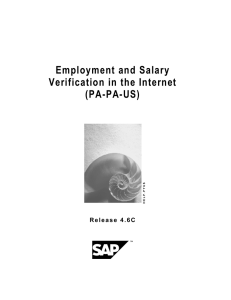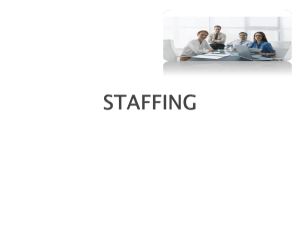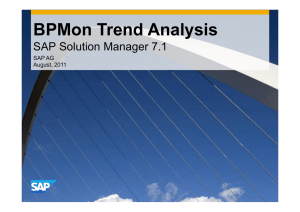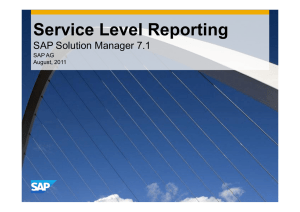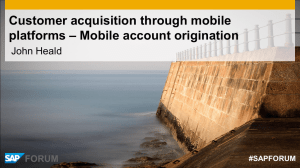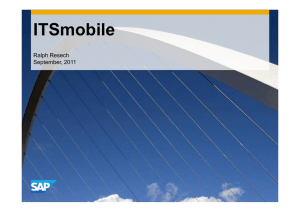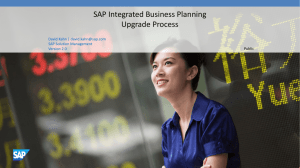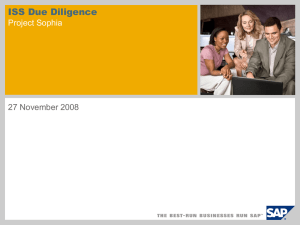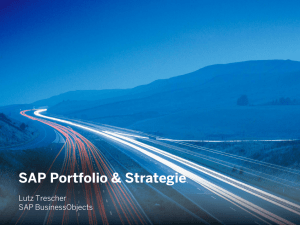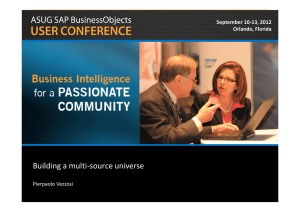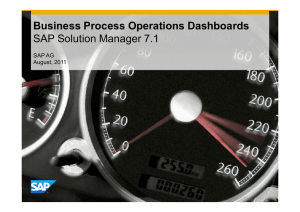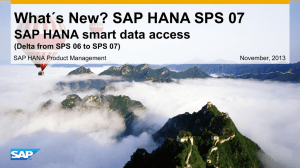Best-Built Applications Guidelines
Werbung
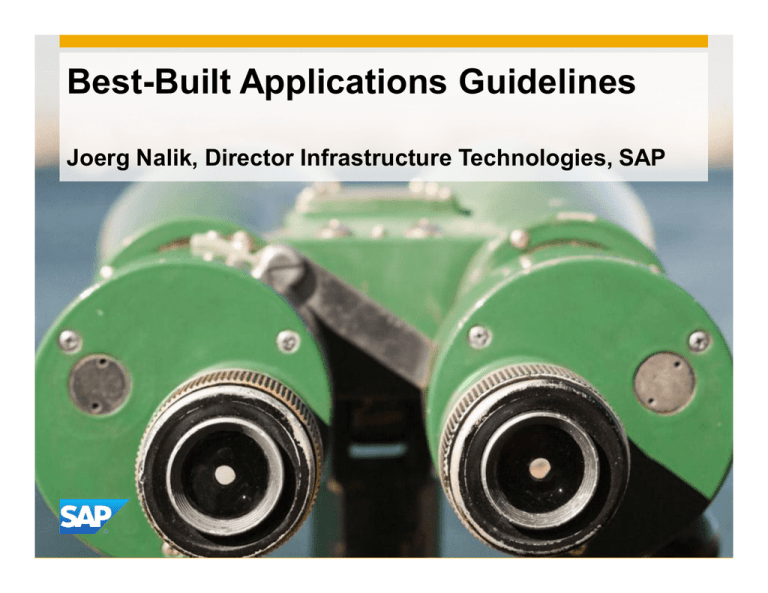
Best-Built Applications Guidelines Joerg Nalik, Director Infrastructure Technologies, SAP SAP Guidelines for Best-Built Applications The Best-Built Applications Guidelines are recommendations from SAP about how to develop complementary software that is aligned with SAP Business Suite Best-Built Applications Guidelines are: • Descriptions of what to do rather than how to do it • Based on standards, best practices, and guidelines used by SAP developers • Iterative and incremental Benefits to Customers and Partners: • Better alignment with SAP’s technology direction • Less re-work, reducing lifetime cost of development • Reduced operational and training costs bestbuiltapps.sap.com © 2011 SAP AG. All rights reserved. 2 Who Benefits from Best-Built Applications Guidelines? 2010: Written for Partners who develop products that integrate with the SAP Business Suite Guidelines for Partners … but also found useful by customers: “These Guidelines also apply to our custom development on SAP solutions” Starting in 2011 the BBA guidelines were updated to apply to both, CUSTOMERS and PARTNERS, who develop products that integrate with the SAP Business Suite © 2011 SAP AG. All rights reserved. 3 Topic Areas Covered as of Today Introduction Application Development Application Lifecycle Management Process Orchestration and Service-Oriented Architecture (SOA) User Interface and User Experience Enterprise Information Management Business Intelligence Tools Security © 2011 SAP AG. All rights reserved. 4 Clear Recommendations For Solution Developers 3 Ways to Develop Solutions The guidelines recognize three valid approaches to solution development: Designed with SAP tools to run in the SAP environment 3 Recommendation Levels The guidelines advise whether a particular technology or technique is: Recommended Migrated to run in the SAP environment Not encouraged Connected to an SAP solution Not recommended © 2011 SAP AG. All rights reserved. 5 Customer Guideline Example Integration, Modification SAP SAP Partner SOA-WS-1. SAP recommends implementing remote consumption of business functionality using loosely coupled, asynchronous, stateless communication using web services. …. Best option for integrating with SAP Business Suite. Fewest release, upgrade and change management dependencies. ALM-ADAPT-1. SAP recommends building add-ons that connect to SAP software via SAP supported interfaces rather than modifying SAP software Good (Abap) option for integrating with SAP Business Suite. Least change management dependencies, consolidation of Abap servers possible. ALM-ADAPT-2. SAP recommends that developers who need to adapt SAP development objects use an SAP enhancement technology rather than modify the SAP software development objects. If no interfaces exist this might be an option to add capabilities to your business application….. ALM-ADAPT-3. SAP recommends making your enhancement add-on projects switchable by using reversible business functions of the Switch Framework. Use of Switch Framework makes debugging easier and can help to reduce deployment and operational costs. © 2011 SAP AG. All rights reserved. 6 Customer and Partner Feedback ” SAP Guidelines for Best-Built Applications … contain pertinent information for any customer doing SAP development. … I consider this a “must read“ for any organization doing application development in and around SAP.” Peter Loop Sr. Principle Architect, Enterprise Application Services Microsoft ” © 2011 SAP AG. All rights reserved. Dolphin plans to utilize the BBA Guidelines for a wide range of product management decisions ranging from selection of specific SAP development framework to the structuring of product documentation. BBA guidelines have already helped us with the choice of UI development technology for the web components of our Add-on solutions.” Vishal Awasthi Chief Technical Officer Dolphin 7 Development Governance Is Recommended! BBA $$$ HIGH RISK Govern for: • Long term supportability, extensibility and low future upgrade efforts • Operational costs, TCD (Total Costs of Development) vs. TCO • Harmonization benefits, end-user training costs • Non functional, must have requirements: security compliance, reliability, performance …. © 2011 SAP AG. All rights reserved. 8 Examples How BBA Has Been Used BBA is a top level document with many pointers to more specialized documentation hubs like SCN. SAP.com, help.SAP.com or Service marketplace service.sap.com. © 2011 SAP AG. All rights reserved. 9 Existing Engagement Opportunities: BBA Resources and Community “In my opinion, the approach to figuring out BBA guidelines should involve the community much more….” Reader Comment Find BBA at bestbuiltapps.sap.com Free BBA book download in PDF and ePub (eBook) format. The BBA book content as Wiki for online reading and comments. The BBA Content: Blogs, Discussions, Documents Latest BBA news and updates. Engage with BBA: Post your comments, questions, feedback and complements on our website! © 2011 SAP AG. All rights reserved. 10 Your Next Steps • Check out BBA. Download it again from bestbuiltapps.sap.com if you don’t have the latest version. • Have your developers, architects and project owners read BBA • Integrate BBA into your development governance • Participate in the BBA community through posting your experiences, questions and feedback on the BBA website. Encourage your development organization to engage with the BBA community. bestbuiltapps.sap.com © 2011 SAP AG. All rights reserved. 11 Thank You © 2011 SAP AG. All rights reserved. No part of this publication may be reproduced or transmitted in any form or for any purpose without the express permission of SAP AG. The information contained herein may be changed without prior notice. Some software products marketed by SAP AG and its distributors contain proprietary software components of other software vendors. Microsoft, Windows, Excel, Outlook, and PowerPoint are registered trademarks of Microsoft Corporation. IBM, DB2, DB2 Universal Database, System i, System i5, System p, System p5, System x, System z, System z10, System z9, z10, z9, iSeries, pSeries, xSeries, zSeries, eServer, z/VM, z/OS, i5/OS, S/390, OS/390, OS/400, AS/400, S/390 Parallel Enterprise Server, PowerVM, Power Architecture, POWER6+, POWER6, POWER5+, POWER5, POWER, OpenPower, PowerPC, BatchPipes, BladeCenter, System Storage, GPFS, HACMP, RETAIN, DB2 Connect, RACF, Redbooks, OS/2, Parallel Sysplex, MVS/ESA, AIX, Intelligent Miner, WebSphere, Netfinity, Tivoli and Informix are trademarks or registered trademarks of IBM Corporation. Linux is the registered trademark of Linus Torvalds in the U.S. and other countries. Adobe, the Adobe logo, Acrobat, PostScript, and Reader are either trademarks or registered trademarks of Adobe Systems Incorporated in the United States and/or other countries. SAP, R/3, SAP NetWeaver, Duet, PartnerEdge, ByDesign, SAP BusinessObjects Explorer, StreamWork, and other SAP products and services mentioned herein as well as their respective logos are trademarks or registered trademarks of SAP AG in Germany and other countries. Business Objects and the Business Objects logo, BusinessObjects, Crystal Reports, Crystal Decisions, Web Intelligence, Xcelsius, and other Business Objects products and services mentioned herein as well as their respective logos are trademarks or registered trademarks of Business Objects Software Ltd. Business Objects is an SAP company. Sybase and Adaptive Server, iAnywhere, Sybase 365, SQL Anywhere, and other Sybase products and services mentioned herein as well as their respective logos are trademarks or registered trademarks of Sybase, Inc. Sybase is an SAP company. All other product and service names mentioned are the trademarks of their respective companies. Data contained in this document serves informational purposes only. National product specifications may vary. The information in this document is proprietary to SAP. No part of this document may be reproduced, copied, or transmitted in any form or for any purpose without the express prior written permission of SAP AG. Oracle and Java are registered trademarks of Oracle and/or its affiliates. UNIX, X/Open, OSF/1, and Motif are registered trademarks of the Open Group. Citrix, ICA, Program Neighborhood, MetaFrame, WinFrame, VideoFrame, and MultiWin are trademarks or registered trademarks of Citrix Systems, Inc. HTML, XML, XHTML and W3C are trademarks or registered trademarks of W3C®, World Wide Web Consortium, Massachusetts Institute of Technology. © 2011 SAP AG. All rights reserved. 13 © 2011 SAP AG. Alle Rechte vorbehalten. Weitergabe und Vervielfältigung dieser Publikation oder von Teilen daraus sind, zu welchem Zweck und in welcher Form auch immer, ohne die ausdrückliche schriftliche Genehmigung durch SAP AG nicht gestattet. In dieser Publikation enthaltene Informationen können ohne vorherige Ankündigung geändert werden. Die von SAP AG oder deren Vertriebsfirmen angebotenen Softwareprodukte können Softwarekomponenten auch anderer Softwarehersteller enthalten. Microsoft, Windows, Excel, Outlook, und PowerPoint sind eingetragene Marken der Microsoft Corporation. IBM, DB2, DB2 Universal Database, System i, System i5, System p, System p5, System x, System z, System z10, System z9, z10, z9, iSeries, pSeries, xSeries, zSeries, eServer, z/VM, z/OS, i5/OS, S/390, OS/390, OS/400, AS/400, S/390 Parallel Enterprise Server, PowerVM, Power Architecture, POWER6+, POWER6, POWER5+, POWER5, POWER, OpenPower, PowerPC, BatchPipes, BladeCenter, System Storage, GPFS, HACMP, RETAIN, DB2 Connect, RACF, Redbooks, OS/2, Parallel Sysplex, MVS/ESA, AIX, Intelligent Miner, WebSphere, Netfinity, Tivoli und Informix sind Marken oder eingetragene Marken der IBM Corporation. Linux ist eine eingetragene Marke von Linus Torvalds in den USA und anderen Ländern. Adobe, das Adobe-Logo, Acrobat, PostScript und Reader sind Marken oder eingetragene Marken von Adobe Systems Incorporated in den USA und/oder anderen Ländern. Oracle und Java sind eingetragene Marken von Oracle und/oder ihrer Tochtergesellschaften. HTML, XML, XHTML und W3C sind Marken oder eingetragene Marken des W3C®, World Wide Web Consortium, Massachusetts Institute of Technology. SAP, R/3, SAP NetWeaver, Duet, PartnerEdge, ByDesign, SAP BusinessObjects Explorer, StreamWork und weitere im Text erwähnte SAP-Produkte und -Dienstleistungen sowie die entsprechenden Logos sind Marken oder eingetragene Marken der SAP AG in Deutschland und anderen Ländern. Business Objects und das Business-Objects-Logo, BusinessObjects, Crystal Reports, Crystal Decisions, Web Intelligence, Xcelsius und andere im Text erwähnte Business-Objects-Produkte und -Dienstleistungen sowie die entsprechenden Logos sind Marken oder eingetragene Marken der Business Objects Software Ltd. Business Objects ist ein Unternehmen der SAP AG. Sybase und Adaptive Server, iAnywhere, Sybase 365, SQL Anywhere und weitere im Text erwähnte Sybase-Produkte und -Dienstleistungen sowie die entsprechenden Logos sind Marken oder eingetragene Marken der Sybase Inc. Sybase ist ein Unternehmen der SAP AG. Alle anderen Namen von Produkten und Dienstleistungen sind Marken der jeweiligen Firmen. Die Angaben im Text sind unverbindlich und dienen lediglich zu Informationszwecken. Produkte können länderspezifische Unterschiede aufweisen. Die in dieser Publikation enthaltene Information ist Eigentum der SAP. Weitergabe und Vervielfältigung dieser Publikation oder von Teilen daraus sind, zu welchem Zweck und in welcher Form auch immer, nur mit ausdrücklicher schriftlicher Genehmigung durch SAP AG gestattet. UNIX, X/Open, OSF/1 und Motif sind eingetragene Marken der Open Group. Citrix, ICA, Program Neighborhood, MetaFrame, WinFrame, VideoFrame und MultiWin sind Marken oder eingetragene Marken von Citrix Systems, Inc. © 2011 SAP AG. All rights reserved. 14
